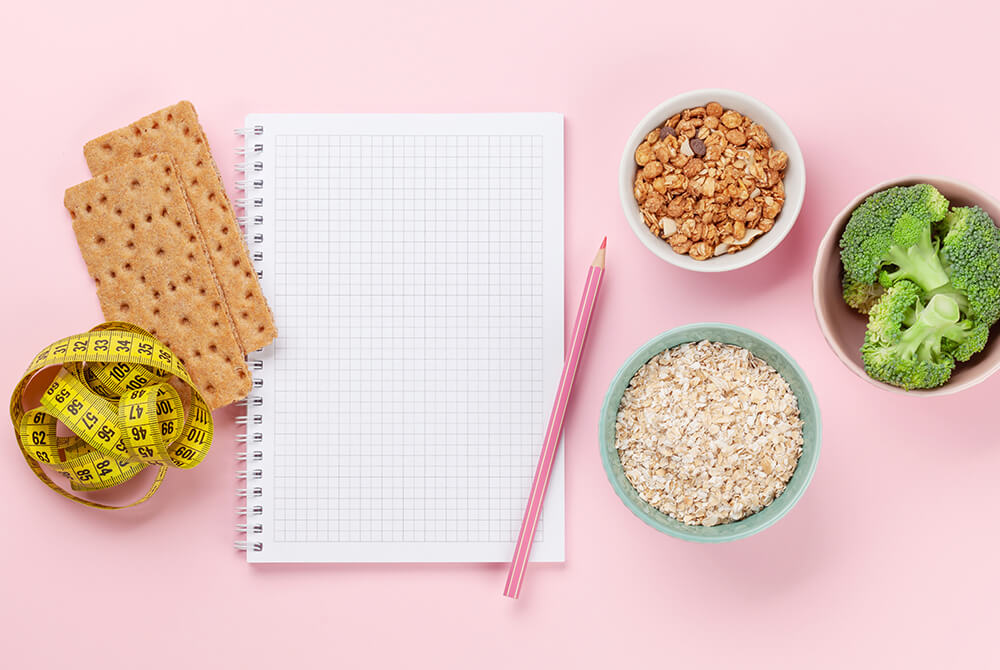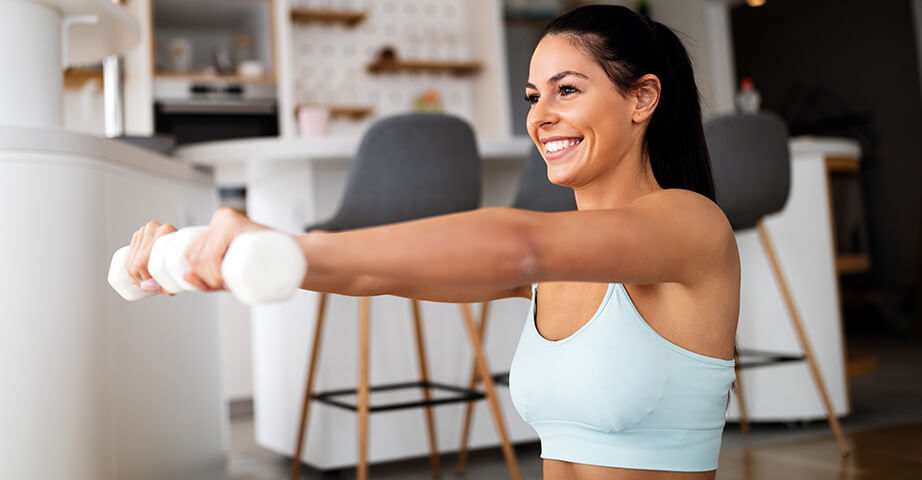Weight-loss diet - principles and recommended products

A reduction diet is a diet to lose weight. Its basic principle is to provide fewer calories than the body consumes per day. At the same time, it should be a healthy diet that satisfies your taste buds and protects you from losing muscle mass. What rules should be followed to make a reduction diet effective? How much protein and carbohydrates to eat? How many meals? What foods are good for reduction? We explain!
Reduction diet - what do you need to know about it?
The reduction diet and weight loss diet are the names of the same diet plan. As the name suggests, the aim of this diet is to reduce weight, or rather to lose body fat while maintaining muscle mass as much as possible.
How many calories in a reduction diet?
A fat-reduction diet requires you to choose a daily calorie menu that enables you to lose weight at a stable, healthy rate. To do this, we first need to establish our calorie requirements, which is the starting point. Here we explain exactly how to do this. Then we proceed to determine the calorie deficit, i.e. the value of calories by which we reduce the calorie content of the daily menu. We write about the deficit in detail here. The most common calorie deficit is about 400-500 kcal. So, for example, if the caloric needs of a person are 2100 kcal, the deficit is set at 500 kcal, then the calorie content of the reduction diet will be 1600 kcal. The calorific value of a reduction diet needs to be set individually, matching it to the starting body weight, the goal you want to achieve, your age, physiological state and physical activity level.
The recommended rate of weight reduction is 0.5-1 kg per week. Faster than this can be dangerous to your health and is a risk of losing too much muscle mass. If the rate of weight loss persists beyond 1 kg per week, the calorie content of the diet should be increased.
Reduction diet - how many meals?
The number of meals in a reduction diet should be adjusted to your own needs - lifestyle, preferences and type of physical activity. For some people, 3 large meals work well, for others 5 smaller meals, or a combination of 3 main meals and an extra post-workout meal. It has been proven many times by scientists that 5 small meals a day do not speed up the metabolism and do not make the body consume more calories. At the same time, 3 large meals do not negatively affect the rate of calorie burning. Therefore, the 5-meal model is not the only valid one during a reduction diet.
How much protein in a reduction diet?
Protein is a key macronutrient in a reduction diet. As it is slowly digested, meals with a high protein content provide satiety for a long time. This is important if we are restricting calories, as it helps to reduce the feeling of hunger. During weight loss, a loss of muscle mass also occurs. This is a normal process of calorie restriction. However, to keep the body strong and healthy, rather than flabby, muscle loss must be prevented. One way of doing this is by increasing the proportion of protein in the diet, preferably in combination with strength training, which stimulates muscle growth. The recommended amount of protein in a reduction diet is 1.8-2 g per kg of body weight, divided across all meals.
Recommended products
Carbohydrates and fat in a fat reduction diet
To make fat reduction more effective, the amount of carbohydrates in meals is reduced in favour of protein. The less physically active a person is, the fewer carbohydrates they need. People who train intensely and are also on a reduction diet need to approach the reduction of carbohydrate intake more carefully, observing whether a lower proportion of carbohydrates in the diet affects wellbeing and sports performance. For most people training moderately on a reduction diet, a scheme providing 40-50% of energy from carbohydrates will work well. If you choose a reduction diet that is based on the principles of a protein-fat diet, carbohydrates will be even less on the daily menu. It all depends on your body's tolerance and choosing the best model for you.
In a reduction diet, do not be afraid of fat. The fat theory, which blamed fat from food for the obesity epidemic, has never been proven; in fact, fat itself has been shown to be less responsible for weight gain than sugar. Fat in meals incredibly increases satiety and is responsible for making them tastier, so it is very useful when losing weight. The average reduction diet provides around 30% of energy from fat.
What should you eat for a reduction?
As well as helping you get rid of body fat, a reduction diet should be healthy and support the proper functioning of the body. To maximally reduce the feeling of hunger, meals should be large and filling. It will be ensured by:
- Vegetables - on a reduction you can eat them in almost unlimited quantities. Vegetables are extremely low in calories and contain fibre and a lot of water, so they fill the stomach, increasing satiety after a meal. There is no better product on a reduction diet than vegetables.
- Lean meats - chicken, turkey, but also lean cuts of pork and beef. The fattier ones can be eaten, too. Just eat less of them than lean ones.
- Fish - any fish. Fish is healthy, we eat too little of it. Both fresh and canned.
- Quark, cottage cheese, skyr - dairy products that are low in calories but high in protein.
- Eggs - are a brilliant, easy-to-use source of protein and fat in the kitchen.
- Legumes - beans, peas, lentils or chickpeas provide carbohydrates and protein at the same time as valuable active substances for health. What legumes should you eat when reducing? How about hummus?
- Cereal products - wholemeal bread is richer in minerals and fibre, and more filling than white bread, which does not mean that white bread should not be eaten on a reduction diet. Add to this cereals, rice and pasta cooked al dente so that they are digested at a slower rate. You don't have to eat only wholemeal pasta on a reduction diet.
- Healthy supplements - nuts, seeds, sesame, peanut butter, olive oil, fruits. They are not a basis for the diet, but a valuable source of nutrients.
- High protein products - the range of high protein products is increasing all the time. This is a great convenience and variety for those wondering what to eat for fat reduction. It is no longer just whey protein powder supplements, but protein bars, country cheese and yoghurts with higher protein content, dairy drinks or milk desserts with added protein and no added sugar.

Products for reduction - what to avoid?
No matter what the diet is, we avoid categorising products into 'forbidden' and 'allowed'. As long as we are not ill, for example with celiac disease, in which gluten is causing real damage to our health, nothing is forbidden. How long is a person able to tolerate the thought that they are NOT allowed to eat that cheesecake when everyone around them is eating? If the motivation is only to lose weight, not for very long. It is better to learn what foods are not beneficial for fat reduction and what to do to minimise the consequences of eating them. These products should be avoided in order to reach the fat loss goal faster. If we do eat them, it is better not to consume them additionally, but to include them on the menu as a substitute for another dish. For example, if we eat cheesecake with a friend in a café, we won't eat our planned afternoon snack. Otherwise, we'll cut down a little on dinner. Or we'll exercise longer when working out. On a reduction diet, there is a way out of every situation.
What foods to avoid during fat reduction?
- Ready-made sweets, yeast, ice cream, cakes - these are sources of simple sugar, very undesirable.
- Salty snacks, crisps - lots of calories in a small volume, you simply won't get full with them.
- Fast food - highly processed food with huge calorific value that is digested instantly. You barely eat, you're already hungry.
- Mayonnaise, cream, ready-made sauces - very high calories in a small volume. On a reduction diet, it's better to save calories so you can eat more of a different thing.
- Juices, fizzy and non-carbonated drinks, sweet coffee - these are liquid calories. They count the same, and you don't get full with them.
